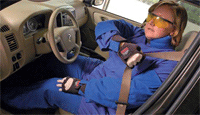First the good news. We’re all living longer. In fact, if you’re reasonably healthy, the chances are that when you go to bed tonight your life expectancy will be five hours greater than it was the same time yesterday. What’s more, it’s now predicted that most of the babies born today in the developed world willive to be 100. Whoever’s on the throne in 2109 will be getting through plenty of stamps.
On a purely selfish level, science’s ability to defer the inevitable is a deeply comforting trend. Most of us would like to live for as long as possible. But the flip side is pretty obvious.
A rapid growth in the number of people living into their late eighties, and a corresponding decrease in the number of younger people presents society with a big problem: more people who can’t look after themselves and fewer people to generate the wealth to look after them.
In Europe in 2000 there were about 62 million people over 65 - by 2050 there will be 103 million. Here in the UK, there are particular concerns about the ‘oldest old’, with the government’s Office for National Statistics (ONS) predicting that the number of people aged 85 and over will more than double by 2033 to around 3.2 million, or five per cent of the expected population.
It’s up there with climate change, feeding the world and averting an energy crisis. And as with all of these other geo-political time-bombs, engineers have a major role to play, both in anticipating the practical challenges, communicating this to policymakers and, crucially, developing the technology.
Garth Johnson, Emeritus Professor of rehabilitation Engineering at Newcastle University, is one of an increasingly vocal group of engineers calling for greater industrial engagement with the issue. He also believes that industry may not be awake to the commercial opportunities presented by the elderly market. ‘I’m not convinced the manufacturing industry realises that there are some very big markets here,’ he told The Engineer. ‘There are some good opportunities to make things, design things and sell things, and I think Britain is quite well placed.’
Johnson is particularly concerned about the so-called dependency ratio; the ratio of working to retired people. ‘At the moment,’ he said, ‘we have a ratio of working people to retired of 5 :1 - by 2050 that ratio will have changed to be 2:1.’
With many of these older people likely to require care, the economic outlook is worrying. According to Johnson, the current cost of residential care is about £18,000 a year. By 2036, there will be about three million people in the UK ages over 85 - if 10 per cent of those people require residential care, it will cost the nation £6bn.
‘At the moment we have a ratio of working people to retired of 5 :1 - by 2050 that ratio will have changed to be 2:1.’Prof Garth Johnson
One way in which engineers could have a direct impact on these figures is through continued developments in the field of digital healthcare, which enables the remote monitoring of a patient’s vital signs and could keep people out of hospital. Digital healthcare is a major area of expertise for the UK and undoubtedly has huge promise in lessening the burden of care. However, it has arguably an even more immediate part to play by helping younger people to reduce the consequences of entering old age in an unfit state.
Talking at a recent conference looking at how engineers can address the ageing time-bomb, James Malone-Lee, a professor from UCL Medical School, provided a salutary reminder of the risks of storing up health problems for later life. And one of the biggest issues, he said, is abdominal fat. ‘[This] is very toxic stuff one of the effects is that it pumps out inflammatory cytokines into the systemic circulation that do a lot of damage. People become insulin resistant, they develop hypertension, and the risk of general vascular disease [one of the major health problems later in life] increases.’ Clearly, the use of technology to inform people about the problems they might be storing up could play a key role in mitigating against some of the more extreme impacts of an ageing population.

Warming to his theme, Malone-Lee turned his critical gaze to a problem with a less high-tech solution: an ill-advised approach to urban planning. A good example of this, he said, is the removal of kerbs in many town centres. Conceived as a solution that would make life easier for those with impaired mobility, the removal of kerbs makes life difficult for those with impaired vision, for whom kerbs are a valuable indicator of where the pavement ends and the road starts. Garth Johnson agrees. ‘At the moment most of the world is not designed for older people with mild impairments - a good example is escalators, which are incredibly dangerous for older people who get off them more slowly than younger people. Engineers have got to get to work in designing the world to work for people who move a bit more slowly and can’t see and hear quite as well.’
One area crying out for a rethink is the UK’s rail infrastructure. According to David Sindall, head of disability and inclusion at the Association of Train Operating Companies (ATOC), almost half of the UK’s 2,600 train stations are currently inaccessible to people with mobility impairments. A cause of a great tension between network rail and the train operating companies, this situation can only be fully resolved with a huge expensive programme of station redesigns. But in the meantime, Sindall’s team has been working on the development of an online tool that will enable passengers to view in detail a virtual version of every single station on the UK network. While it won’t improve accessibility directly, the so-called Stations Made Easy tool, due to be launched this month, enables users to plan a route around the station, view images of each point along this route, and interrogate these images in fine detail.
But just as greater numbers of elderly people are using public transport, so are the roads experiencing a rise in the number of elderly users. And here, there’s an entirely different set of problems. (see box). According to US figures, fatality rates among older drivers place them in the same risk group as teenagers. To address this, engineers must find ways of compensating for the cognitive decline experienced by the elderly. Here, advances in telematics and driver assistance technologies - such as lane departure warning systems, or blind-spot monitoring devices - could have a major impact.
Interestingly, many of these technologies are not designed with exclusively elderly users in mind. And this gets straight to the heart of a concept that engineers believe is essential when making products for the elderly: inclusive design. The idea is simple: if you can make something better for older people, you can make it better for everyone.
According to Simon Smith, a senior consultant at Cambridge Consultants, a simple way of achieving this is by employing good common sense design principles right from the beginning. ‘It’s not rocket science - when you design a product for the elderly there’s no excuse not to actually involve them from the very beginning,’ he said. Smith stressed that this process is nevertheless a bit more complicated than simply asking a bunch of elderly people what they would like. ‘You don’t ask people what they want - because you arrive at mediocrity - what you must do is find out what people need and a lot of the time they may not realise they actually need it.’ A good example of this process working, believes Smith, is an internet radio designed by his firm that took as its starting point research indicating that on average people listen to no more than four radio stations. The refreshingly function-light Q2 Cube - designed to appeal to both elderly and younger consumers - is due to be launched before Christmas. But if it’s really so straightforward to design products that suit everyone, why are there so many examples of bad design?
Garth Johnson agrees that industry appears to have a blind spot when it comes to the elderly. ‘One of the biggest mechanical engineering successes of the last 30-40 years is the design of total joint replacements,’ he said. ‘They virtually always work, they’re very, very successful and they are completely engineering devices. That’s something that engineers have done that has worked to maintain people. But strangely, things that we all use really commonly have not been modified or changed or redesigned to take these sorts of people into account. Dyson doesn’t make a vacuum cleaner for old people - why not? Has he ever thought about making his appliances suitable for all ages?’ It is to be hoped that engineers engage on a grand scale with the challenges and the commercial opportunities they present sooner rather than later. For all our sakes.
Land of the Living
Trends indicate a large increase in the number of people over 65
- A child born today in the developed world has a life expectancy of 100
- Life expectancy in the developed world is going up by five hours a day
- In 2000, there were 62 million people in Europe over 65. By 2050, this is expected to hit 103 million.
- Today in the UK the ratio of workers to pensioners is 5:1. On current trends, this will be 2:1 by 2050
- By 2036 there will be about three million people in the UK ages over 85 - if 10 per cent of those people require residential care that will cost the nation £6bn

Designing for older drivers
Car makers already employ techniques to make driving safer and more comfortable for older people
Anticipating and understanding the needs of your customers is perhaps the most critical tenet of good design, and the auto industry, increasingly mindful of the rising number of elderly motorists, has perhaps been quicker than most to anticipate these needs.
Designers at both Nissan and Ford now both make regular use of so-called ageing suits, specially developed clothing that mimics many of the impairments associated with old age.
Made of materials that restrict movement of the knees, elbows, back and neck, these suits also use gloves to reduce the sense of touch, and goggles to simulate blurry vision. The Nissan suit has a 2in-thick waist belt that duplicates middle-age spread, while the Ford suit adds bulk in the knees, elbows, stomach and back to reduce flexibility and manoeuvrability. Both companies now use the suits as key tools in the design process. Indeed, according to Ford, its Third-Age suit played a major role during the development of the Ford Focus, with the restricted mobility experience by suit-wearing designers thought to be behind the decision to make the car taller than its predecessor, the Escort.
Ford’s designers are also looking into a range of technologies that will help protect older drivers in the event of a crash including the world’s first inflatable seat belts, due to be installed next year in the US on the Ford Explorer. The new restraint - a combination of traditional seat belt and airbag systems - has been designed to provide additional protection for rear-seat passengers, and particularly those more vulnerable to injuries such as older passengers or children.





Nanogenerator consumes CO2 to generate electricity
Whoopee, they've solved how to keep a light on but not a lot else.